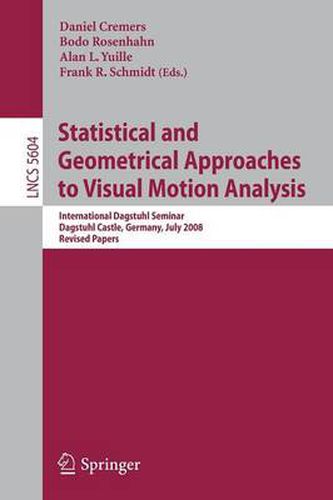Readings Newsletter
Become a Readings Member to make your shopping experience even easier.
Sign in or sign up for free!
You’re not far away from qualifying for FREE standard shipping within Australia
You’ve qualified for FREE standard shipping within Australia
The cart is loading…






This title is printed to order. This book may have been self-published. If so, we cannot guarantee the quality of the content. In the main most books will have gone through the editing process however some may not. We therefore suggest that you be aware of this before ordering this book. If in doubt check either the author or publisher’s details as we are unable to accept any returns unless they are faulty. Please contact us if you have any questions.
Motion analysis is central to both human and machine vision. It involves the interpretation of image data over time and is crucial for a range of motion tasks suchasobstacledetection,depthestimation,videoanalysis,sceneinterpretation, videocompressionandotherapplications. Motionanalysisis unsolvedbecauseit requires modeling of the complicated relationships between the observed image data and the motion of objects and motion patterns (e. g. , falling rain) in the visual scene. The Dagstuhl Seminar 08291 on Statistical and Geometrical Approaches to Visual Motion Analysis was held during July 13-18, 2008 at the International Conference and Research Center (IBFI), Schloss Dagstuhl, near Wadern in G- many. The workshop focused on critical aspects of motion analysis, including motion segmentation, the modeling of motion patterns and the di?erent te- niques used. These techniques include variationalapproaches,level set methods, probabilistic models, graph cut approaches, factorization techniques, and neural networks. All these techniques can be subsumed within statistical and geomet- cal frameworks. We further involved experts in the study of human and primate vision. Primatevisualsystemsareextremely sophisticatedat processingmotion, thus there is much to be learnt from studying them. In particular, we discussed how to relate the computational models of primate visual systems to those - veloped for machine vision. In total, 15 papers were accepted for these proceedings after the workshop. We werecarefulto ensurea high standardof qualityfor the accepted papers. All submissions were double-blind reviewed by at least two experts.
$9.00 standard shipping within Australia
FREE standard shipping within Australia for orders over $100.00
Express & International shipping calculated at checkout
This title is printed to order. This book may have been self-published. If so, we cannot guarantee the quality of the content. In the main most books will have gone through the editing process however some may not. We therefore suggest that you be aware of this before ordering this book. If in doubt check either the author or publisher’s details as we are unable to accept any returns unless they are faulty. Please contact us if you have any questions.
Motion analysis is central to both human and machine vision. It involves the interpretation of image data over time and is crucial for a range of motion tasks suchasobstacledetection,depthestimation,videoanalysis,sceneinterpretation, videocompressionandotherapplications. Motionanalysisis unsolvedbecauseit requires modeling of the complicated relationships between the observed image data and the motion of objects and motion patterns (e. g. , falling rain) in the visual scene. The Dagstuhl Seminar 08291 on Statistical and Geometrical Approaches to Visual Motion Analysis was held during July 13-18, 2008 at the International Conference and Research Center (IBFI), Schloss Dagstuhl, near Wadern in G- many. The workshop focused on critical aspects of motion analysis, including motion segmentation, the modeling of motion patterns and the di?erent te- niques used. These techniques include variationalapproaches,level set methods, probabilistic models, graph cut approaches, factorization techniques, and neural networks. All these techniques can be subsumed within statistical and geomet- cal frameworks. We further involved experts in the study of human and primate vision. Primatevisualsystemsareextremely sophisticatedat processingmotion, thus there is much to be learnt from studying them. In particular, we discussed how to relate the computational models of primate visual systems to those - veloped for machine vision. In total, 15 papers were accepted for these proceedings after the workshop. We werecarefulto ensurea high standardof qualityfor the accepted papers. All submissions were double-blind reviewed by at least two experts.